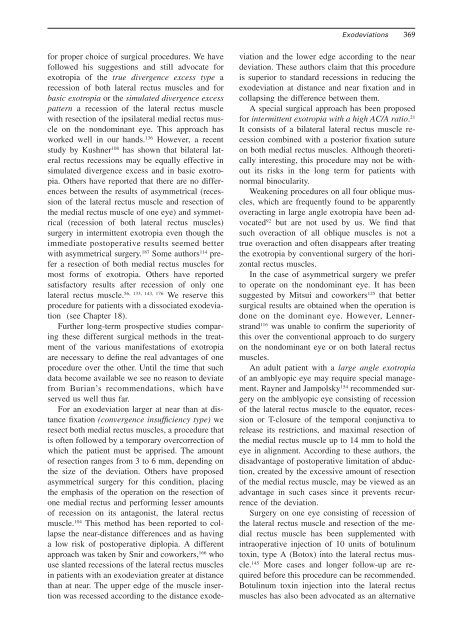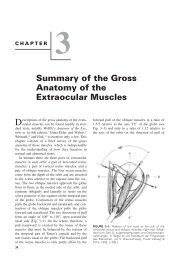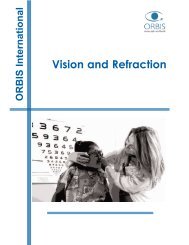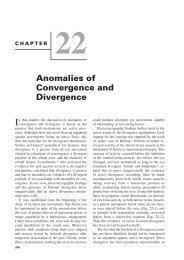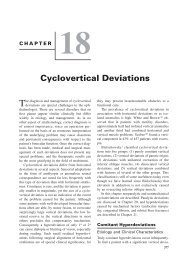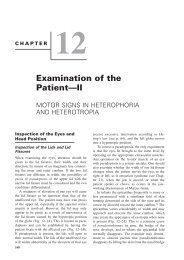Chapter 17: Exodeviations
Chapter 17: Exodeviations
Chapter 17: Exodeviations
You also want an ePaper? Increase the reach of your titles
YUMPU automatically turns print PDFs into web optimized ePapers that Google loves.
<strong>Exodeviations</strong> 369for proper choice of surgical procedures. We havefollowed his suggestions and still advocate forexotropia of the true divergence excess type arecession of both lateral rectus muscles and forbasic exotropia or the simulated divergence excesspattern a recession of the lateral rectus musclewith resection of the ipsilateral medial rectus muscleon the nondominant eye. This approach hasworked well in our hands. 136 However, a recentstudy by Kushner 108 has shown that bilateral lateralrectus recessions may be equally effective insimulated divergence excess and in basic exotropia.Others have reported that there are no differencesbetween the results of asymmetrical (recessionof the lateral rectus muscle and resection ofthe medial rectus muscle of one eye) and symmetrical(recession of both lateral rectus muscles)surgery in intermittent exotropia even though theimmediate postoperative results seemed betterwith asymmetrical surgery. 187 Some authors 114 prefera resection of both medial rectus muscles formost forms of exotropia. Others have reportedsatisfactory results after recession of only onelateral rectus muscle. 56, 133, 143, <strong>17</strong>6 We reserve thisprocedure for patients with a dissociated exodeviation(see <strong>Chapter</strong> 18).Further long-term prospective studies comparingthese different surgical methods in the treatmentof the various manifestations of exotropiaare necessary to define the real advantages of oneprocedure over the other. Until the time that suchdata become available we see no reason to deviatefrom Burian’s recommendations, which haveserved us well thus far.For an exodeviation larger at near than at distancefixation (convergence insufficiency type) weresect both medial rectus muscles, a procedure thatis often followed by a temporary overcorrection ofwhich the patient must be apprised. The amountof resection ranges from 3 to 6 mm, depending onthe size of the deviation. Others have proposedasymmetrical surgery for this condition, placingthe emphasis of the operation on the resection ofone medial rectus and performing lesser amountsof recession on its antagonist, the lateral rectusmuscle. 104 This method has been reported to collapsethe near-distance differences and as havinga low risk of postoperative diplopia. A differentapproach was taken by Snir and coworkers, 166 whouse slanted recessions of the lateral rectus musclesin patients with an exodeviation greater at distancethan at near. The upper edge of the muscle insertionwas recessed according to the distance exodeviationand the lower edge according to the neardeviation. These authors claim that this procedureis superior to standard recessions in reducing theexodeviation at distance and near fixation and incollapsing the difference between them.A special surgical approach has been proposedfor intermittent exotropia with a high AC/A ratio. 21It consists of a bilateral lateral rectus muscle recessioncombined with a posterior fixation sutureon both medial rectus muscles. Although theoreticallyinteresting, this procedure may not be withoutits risks in the long term for patients withnormal binocularity.Weakening procedures on all four oblique muscles,which are frequently found to be apparentlyoveracting in large angle exotropia have been advocated92 but are not used by us. We find thatsuch overaction of all oblique muscles is not atrue overaction and often disappears after treatingthe exotropia by conventional surgery of the horizontalrectus muscles.In the case of asymmetrical surgery we preferto operate on the nondominant eye. It has beensuggested by Mitsui and coworkers 125 that bettersurgical results are obtained when the operation isdone on the dominant eye. However, Lennerstrand116 was unable to confirm the superiority ofthis over the conventional approach to do surgeryon the nondominant eye or on both lateral rectusmuscles.An adult patient with a large angle exotropiaof an amblyopic eye may require special management.Rayner and Jampolsky 154 recommended surgeryon the amblyopic eye consisting of recessionof the lateral rectus muscle to the equator, recessionor T-closure of the temporal conjunctiva torelease its restrictions, and maximal resection ofthe medial rectus muscle up to 14 mm to hold theeye in alignment. According to these authors, thedisadvantage of postoperative limitation of abduction,created by the excessive amount of resectionof the medial rectus muscle, may be viewed as anadvantage in such cases since it prevents recurrenceof the deviation.Surgery on one eye consisting of recession ofthe lateral rectus muscle and resection of the medialrectus muscle has been supplemented withintraoperative injection of 10 units of botulinumtoxin, type A (Botox) into the lateral rectus muscle.145 More cases and longer follow-up are requiredbefore this procedure can be recommended.Botulinum toxin injection into the lateral rectusmuscles has also been advocated as an alternative


